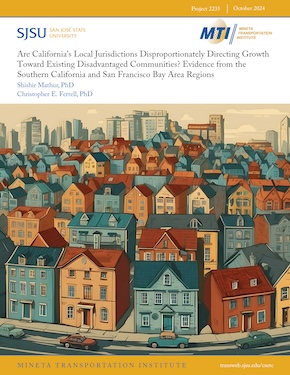- 408-924-7560
- mineta-institute@sjsu.edu
- Donate
Are California’s Local Jurisdictions Disproportionately Directing Growth Toward Existing Disadvantaged Communities? Evidence from the Southern California and San Francisco Bay Area Regions
Communities across the United States are striving to promote smart urban growth through compact urban infill residential development. They are doing so to mitigate sprawl's negative fiscal, environmental, social, and physical impacts, strengthen land use-housing-transportation linkages, and develop at densities needed for well-functioning public transit. Some states, such as California, have gone a step further by linking compact urban infill development as critical to meeting greenhouse gas (GHG) reduction targets. Anecdotal evidence suggests some California local jurisdictions are planning disproportionately large amounts of new urban development in disadvantaged communities (DACs). However, empirical evidence is lacking. This study aims to fill this gap. Using the two most populated regions of the state—the San Francisco Bay Area (S.F. Bay Area) and Southern California (SoCal)—as case studies, this research finds that the new housing is disproportionately planned in DACs in both the case study regions. Specifically, of the areas earmarked for future growth, close to a quarter (22%) are disadvantaged in the S.F. Bay Area region and close to half (48%) in the SoCal region. Meanwhile, the total area of the region that is disadvantaged is only 14% and 26%, respectively. These findings are critical for equity implications in policy and planning in these areas and beyond.
SHISHIR MATHUR, PHD
Dr. Shishir Mathur is an MTI Research Associate and a Professor of Urban and Regional Planning at San Jose State University. He served as Associate Dean of Research (College of Social Sciences) during 2016-2019 and the Director of the Certificate in Real Estate Development during 2016-2020. His research interests include transportation finance, urban and real estate economics, affordable housing, international development, infrastructure and development finance, and growth management. His research has been published in top-tier journals such as Transportation Research Part A, Transport Policy, Journal of Planning Education and Research, Urban Studies, Land Use Policy, Cities, and Habitat International. He is the author of three books: Development Charges: Funding Urban Infrastructure in India and the Global South (Cambridge University Press), Understanding India’s New Approach to Spatial Planning and Development: A Salient Shift? (Oxford University Press) and Innovation in Public Transport Finance: Property Value Capture (Routledge). Dr. Mathur has advised several international and national organizations. United Nations Human Settlements Programme (UN-HABITAT) sought his input on ways to encourage land-based financing in Africa, Asia, and South America. He advised Federal Transit Administration on ways to promote land value capture to fund transit-oriented developments and transit infrastructure.
CHRISTOPHER E FERRELL, PHD
Dr. Christopher E. Ferrell began his career in 1995 as a planner for the Metropolitan Transportation Commission (MTC). He completed his doctoral studies in City and Regional Planning at the University of California at Berkeley in 2005 and worked as a consultant with Dowling Associates, Inc. for 10 years before leaving to help form CFA Consultants in 2010. He is currently a principal, board member, and the executive director of the Transportation Choices for Sustainable Communities Research and Policy Institute, a 501c3 nonprofit. He has been the principal investigator for several research projects for the Mineta Transportation Institute, where he has been a Research Associate since 2005. His research focuses on the relationships between transportation and land use, livability, travel behavior, transportation policy, and planning related institutional structures. His research experience includes the study of multimodal transit and freeway corridors, best practices for building successful transit-oriented development, the effects of transit-oriented development on surrounding property values, the effects of neighborhood crimes on transportation mode choice, and a set of methods, metrics and strategies for evaluating transit corridor livability. As a practitioner, he has planned mixed-use, infill and transit-oriented development projects, analyzed the impacts of specific and general plans, planned and implemented intelligent transportation systems, and developed bicycle and pedestrian plans. He has taught several quantitative methods classes in the San José State University Urban Planning Department and a course in transportation and land use in the City and Regional Planning Department at the University of California at Berkeley.
-
Contact Us
San José State University One Washington Square, San Jose, CA 95192 Phone: 408-924-7560 Email: mineta-institute@sjsu.edu






